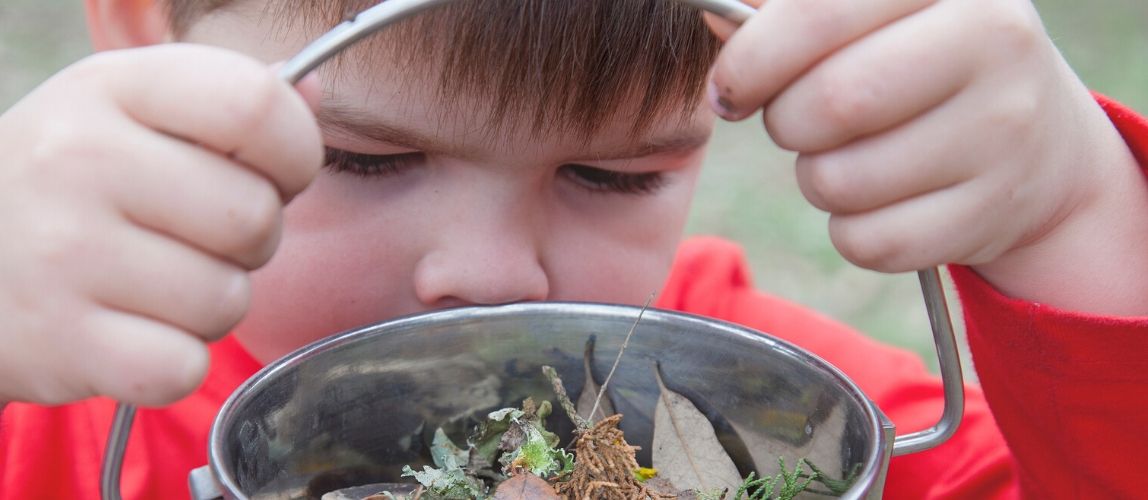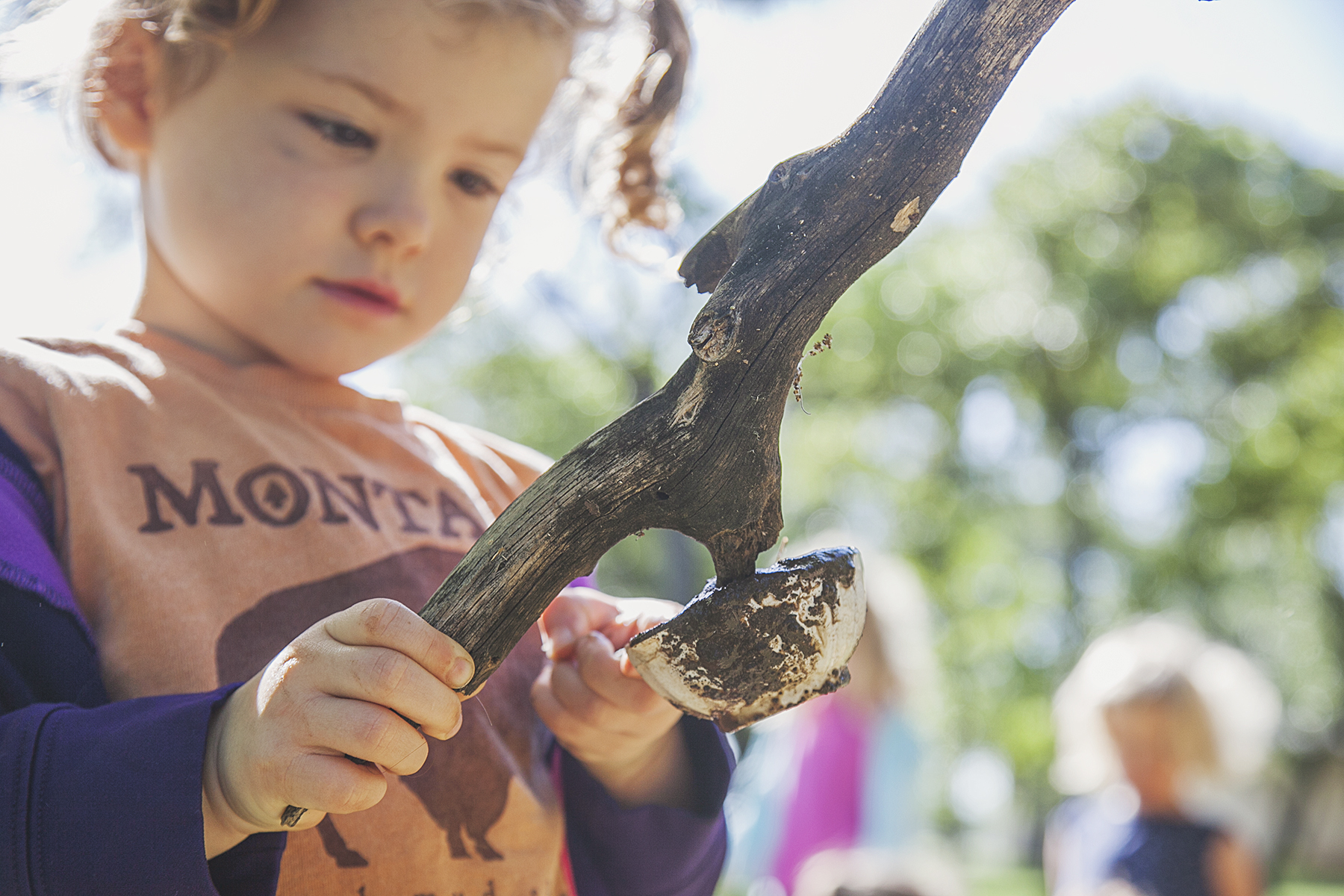1. Learn more about the basics:
Check out "Making Sense of Sensory Development"—the first post in our series on sensory development. Our bodies are amazing! Knowing a few basic concepts can help us leapfrog in our understanding about how senses impact our kids' learning and how we can support sensory development.
2. Go outside—all the time:
Nature truly is the ideal, sensory learning environment. No matter the age of your child, being in nature surrounds them with stimulation for all of their senses. It is both calming and stimulating in equal and wonderfully balanced parts. There is no better state for learning than being simultaneously settled and alert.
"The woods were my Ritalin. Nature calmed me focused me and yet excited my senses."—Richard Louv
Outdoors also allows us to open up the container and let kids seek their own level of sensory input—helping them to find their just right level of sensory learning, too. Messy play is so much easier and play is more free in general when we take the walls away!
3. Look for activities that include chances to use multiple senses:
The more senses kids use, the better. We can choose materials and a setting that gives kids opportunities to use various senses together. On our DIY Activity site, you can find many different ways to support multiple senses, including some of our favorites like: Bubbles!, Parts and Wholes, and Catching Colors.
4. Imagine your child's sensory cup:
Each child experiences sensory stimulation differently and has a different threshold for sensory input. To help make sense of this, you can use a simple metaphor—the sensory "cup."
Imagine your child has an internal sensory cup that is right-sized for them.
That cup fills up the more sensory stimulation they experience. If your child's cup is large, it takes a lot of stimulation to get full (i.e., rolling in the mud vs. touching the mud; jumping off a log vs. a quick hop). If that cup is small, even a relatively small amount of sensory input can overflow the cup and lead to an overwhelming experience.
For example, my middle child's cup is quite large, and he nearly always comes back from our neighboring farm covered in mud. My oldest, however, has a much smaller cup and has worked over the years to make friends with mud, still preferring to use tools as intermediaries during mud play.
How can the sensory cup metaphor help us support kids?
This metaphor in particular helps us step back and observe our children's unique approaches to sensory inputs. When we start to gauge the size of their "sensory cup," we start to leave space for their needs as a learner, and we tend to give them more agency to direct their own sensory play.
Since I can envision my kids' cups as different in capacity, I can see that both of them are stimulated by their own versions of mud play. My middle child is not "better" at mud play because they go "all in." Both children have rich experiences that are just right for them. I have learned to manage the messy aftermath of my middle child's sensory play. And, my steady patience with my oldest has offered them greater access to sensory-rich play than they would have if I had rushed them along.
It is also worth noting that, for some kids, their cup is relatively same sized no matter what type of sensory input they are experiencing. While, for others, they may have a large cup for one sense, but a small cup for another. For example, they may seek a great deal of tactile stimulation for their sense of touch, but they are very sensitive to loud noises.
Take a look at your child's sensory play and wonder with curiosity as to the size of their sensory cup. That simple framing should make it easier to imagine their internal experience and support them by following their lead in play.
5. Warm up the senses before we use them:
To support children at easing into sensory play, we can also help them activate or warm up the sense(s) they will be using ahead of time. This warm up makes the transition to stimulating that sense much smoother and easier. To stick with mud play as an example, you can help your child activate their sense of touch to help them prepare for the stimulation to come.
Here's an example: Before you start to play with mud, simply rub your hands together for about as long as you're supposed to wash hands (~2 Happy Birthdays). In Tinkergarten class, we call it "warming up our mud hands." (You can even sing, Happy Mud Play to us...).
6. Offer tools and modify play activities to lessen sensory overload:
To stick with the sense of touch and mud play example, you can also offer tools like sticks, rocks, or leaves to reduce the intensity of the sensory input kids get from the mud. Pushing a stick into the muddy ground still gives kids gobs of sensory feedback. Giving kids an intermediary tool allows them to still experience the texture of mud through that object, rather than directly on their skin.
7. Balance vestibular input with proprioceptive:
This tip has to do with two very important senses that often go "hidden" to most of us—proprioception and the vestibular system.
If your child gets a bit overwhelmed by spinning, swinging or other activities that stimulate the vestibular system, it can help to continue to help your child keep the doses of vestibular input small. For example, you can welcome a child to spin just once or twice around, swing softly, or simply bend up and down a bit.
You can also help balance vestibular input by following up with some heavy work that activates the joints and muscles, delivering proprioception. Pairing vestibular input with a little proprioception tends to ground kiddos and balance off the vestibular input a bit.
For example, our youngest and I can easily get car sick, and we get dizzy after just a few feet of rolling down the hill—our vestibular systems are easily overwhelmed. But, our family loves to roll down the hill together, and we are suckers for it. We have both found that, if we follow up the family roll with activities like jumping, wheelbarrows, or even push-ups, we are better able to manage the overloaded feeling.
8. Support kids when they are overwhelmed:
Trust the signs, and try to view kids' behavior as the result of a mismatch between that internal cup and the amount of stimulation in the environment vs. poor behavior. This is especially important when we are responding to sensory-seeking behavior that may be mislabeled as "aggressive" or "mean." And, this can be just as important for us to remember when we are observing other people's children in a group setting.
To support kids who are overwhelmed, we can stay calm, switch up the activity to minimize the sensory stimulation and even change to a less stimulating environment, if it is clear our kiddos need that. There will always be other chances to create opportunities to help kids stretch their sensory cups. Forcing sensory play on an overwhelmed child is only likely to increase fear and avoidance in the future.
9. Sometimes WE need help with sensory-rich, messy play!
Sometimes our sensory cups are smaller than our kids', or maybe we just don't have the energy to manage the messy side of sensory-rich play. We get it, and we've put together a whole post just for us adults with tips and tricks to keep our sanity while we support messy play.
Wondering about your child's sensory needs?
Early on, it can feel challenging to understand what about a child's reaction to their environment is/is not cause for concern. We may notice that our child appears to either seek or avoid sensory input, but is that just part of their approach as a learner? And, will they thrive in time given regular opportunities to engage in more sensory activities? Or, might a child struggle with integrating sensory input in such a way that they would benefit from specific, expert support?
If you are concerned, connect with doctors and school staff (if applicable) to help identify experts who can support your child. You can also find accessible resources and supportive community through organizations like Understood.org and the Child Mind Institute.
Keep learning about the senses!
Indeed, our bodies and our senses are elegant, complicated things. But, just a little knowledge about how they work and how to support the natural sensory development process our kiddos were designed to experience can make a huge impact on our kids’ learning. Keep learning more with us!
- Read the introductory post in our sensory learning series, Making Sense of Sensory Development
- Read more about our “sixth sense”—proprioception.
- Read more about a hidden sense on which all others balance—the vestibular sense.
Or, come to Tinkergarten this Summer and learn about how to support your child’s sensory development with us. Find classes in your area at tinkergarten.com/classes, or join one of our at home summer classes from anywhere!

